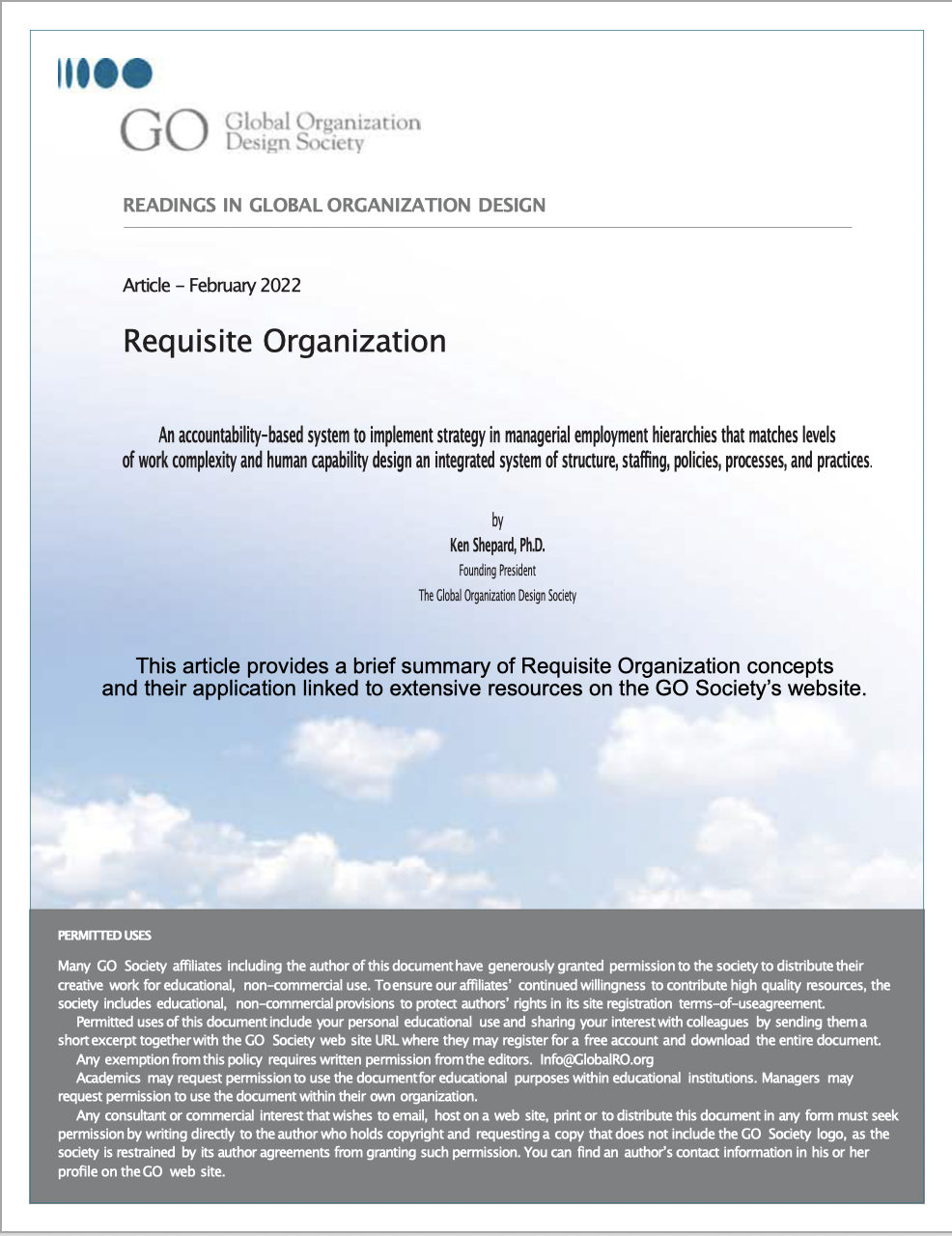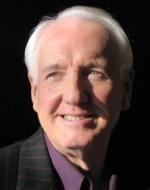An accountability-based system to implement strategy in managerial employment hierarchies that matches levels of work complexity and human capability to design an integrated system of structure, staffing, policies, processes, and practices.
Requisite
Organization Design[1]
An accountability-based system to implement strategy
in managerial employment hierarchies that matches levels of work complexity and human capability to design an integrated system of structure, staffing, policies, processes, and practices.
(Revised and enlarged from an article submitted to the Handbook of Systems Sciences)
by
Ken Shepard, Ph.D. Founding President
The Global Organization Design Society
December 2020
Click here for a pdf version of this article
Roots and evolution
“Requisite Organization (RO) is the only systematic scientific approach to management. A unified whole system for effective managerial leadership that is integrated, flexible, fair and effectively productive.”[2] It is an accountability-based system to design and implement strategy in managerial employment hierarchies to match the concepts of levels of work complexity and human capability.
The system has its roots in the Glacier Project in the UK in the 1950s and early 1960s, where Wilfred Brown, CEO of the Glacier Metal Company, and his consultant Elliott Jaques, a founding member of the Tavistock Institute, collaborated in a long term action learning project. They were seeking to discover effective ways to organize based on understanding human development and the nature of work.
The approach has since evolved in theory and practice, spreading from one company to a clinically focused academic group at Brunel University (BIOSS)[3], to a national center (The Glacier Institute of Management), and then to worldwide practice primarily in English speaking countries but also in Argentina, Sweden, Brazil, Russia and now the Middle East.
Uniqueness
Requisite Organization stands apart from the Management Theory Jungle[4] in a number of important ways:
- Requisite Organization is the only integrated management system:
- More variables are included at each level of the organization, all clearly defined.
- Relationships among elements of structure, processes, and people are specified and mutually reinforcing.
- RO treats the organization as an open system and treats departments as open systems within it. Extensive feedback loops are included to balance dynamics such as context setting, cross-functional relationships with conflicts resolved by the manager once removed, and management practices that build trust and provide a dialogue, and install mechanisms for correction.
- Managers (at levels IV and above) are accountable for systems thinking[5] that includes improving and redesigning systems to fit a shifting environment and changing business models and strategies.
- RO serves as a framework theory in which some partial methods and approaches can be implemented more effectively. E.g. W. Edwards Deming’s statistical process control is completely consistent with RO. Requisite Organization is often used to improve process redesign and digital transformation projects.
- Distinct among management approaches, RO is the only theory to define and operationalize a theory of vertical levels of an organization tied to matching defined levels of work complexity to naturally occurring variations in human capability.
- Unusual as a normative theory, RO lays out ideal design principles but also predicts specific problems when its principles are not utilized.
- RO is designed so that managers are not required to delegate their managerial tasks to others or to experts. While learning and installing the system requires experienced external support, RO is simple enough so that managers can use aspects of it for daily application.
- While designed for managerial employment hierarchies, some of its concepts such as the cross-functional role templates, are also useful in partnerships, collegiums, and voluntary organizations.
Research foundations
The Requisite Organization Annotated Bibliography[6] is now in its 6th edition and is over 2000 pages in length. Materials directly related to various aspects of Requisite Organization include:
- Books - (72)
- Dissertations - (134)
- Masters theses - (70)
- Peer-reviewed articles in elite journals - (253) within the larger number - (816) in all journals
One book noteworthy for its description of research on a number of RO templates is Ronald Capelle’s Optimizing Organization Design: A Proven Approach to Enhance Financial Performance, Customer Satisfaction and Employee Engagement.[7]
Uses
A typical project based on organization-wide Requisite Organization begins with CEO sponsorship and orientation. It proceeds to interviews with the senior managers to determine levels of complexity in roles and the number of layers required in the organization to implement the desired strategy. Sample interviews are conducted elsewhere in the organization to aid in establishing functional alignment and clearly define cross-functional relationships. Employees’ cognitive capabilities are judged for work at different levels and roles are staffed appropriately. Managerial leadership practices and talent pool processes are implemented, and the compensation system is redesigned relative to work levels.
Complete projects often take two or more years. On the other hand, one or more RO concepts can be used to improve performance in different functions, on different levels, and in different processes. One can start anywhere. In a 2002 presentation to the American Psychological Association, Elliott Jaques described how Requisite could be used to diagnose and resolve a myriad of organizational issues.[8]
Examples of uses of RO theory include:
- Re-evaluation of corporate board practices regarding executive compensation based on the level of complexity of the firm’s strategy.
- Redesigning the strategic planning process including a competitive analysis that determines the level of a competitor’s key functions and, if necessary, upshifting the level of one’s own key functions required to gain strategic advantage.
- Determining how adopting strategies for earth sustainability or digital transformation may require increased levels of work.
- Due diligence in assessing and then integrating acquisitions.
- Redesigning for significant improvement of many types of other organizational interventions. E.g. Correcting failing Enterprise System projects by putting project leadership at the right level and installing requisite functional relationships.
- Improving organization culture by removing all status differentials except those based on capability.
- Redesigning and balancing policies, procedures, and work processes throughout the organization.
Applications around the world
Often the first questions many general managers ask are, “Who has used these methods before?” “Anybody in my industry?” “Can I talk to the CEO there?” The Global Organization Design Society has identified several hundred organizations[9] worldwide on public record as having used aspects of RO in their organization.
Noteworthy projects include:
- Bridgewater Associates LP - one of the world’s largest hedge funds, uses cognitive testing based on RO to recruit the best and brightest.
- Brookfield's Private Equity Group currently uses RO as part of its due diligence in evaluating potential acquisitions
- Tata Group - RO concepts of human capability and talent pool management are used to manage talent across all 90 Tata companies.
- Royal Dutch/Shell - used RO from 1995 to 2005 to level and integrate its country-based business units into an effective global corporation.
- Unilever - completed a major global implementation of David Billis’s Work Levels Approach[10]
- The UK’s National Health Service - decentralization projects from the late 60s through the 70s used levels-based social analysis to reorganize many parts of the NHS producing further conceptual developments and several books.
- The Levinson Institute - has produced RO-based workshops for general managers since the early 1970s and has supported many organizational projects catalyzed by those workshops -- Algoma Steel being one of its most comprehensive and successful.
- US Army - Elliott Jaques supported projects starting in 1978 with some continuing as late as 2009. Initially working on the cognitive skills required by the general staff, he then expanded to many RO-based redesigns of both uniformed and non-uniformed units.
- CRA - Sir Roderick Carnegie, CEO of this Australian mining company, part of Rio Tinto, produced a video[11] to describe his use of RO through the 1980s to redesign the 25 business units in this 25,000 employee conglomerate. CRA’s success catalyzed RO use by other major mining companies including BHP Billiton, Anglo American, INCO, and AngloGold Ashanti.
- Argentine projects - One of Jaques’s doctoral students at Brunel, established an RO-based practice in Buenos Aires in the early 1980s while he also taught RO to graduate students in universities. Some of his students went on to establish their own RO-based firms serving clients throughout Latin America. One of the most comprehensive, impactful Argentine projects (1990 to date) was that of Acindar Steel.
The society provides videos of many CEOs speaking about their firm’s experience using RO. Of special note is a video called The CEO’s Perspective[12].
The Society’s ongoing census of RO-based consultants[13] provides the basis for our estimate that there are over 500 trained RO-based consultants. Countless thousands of managers have been trained over the past 60 plus years to use the system as part of their roles.
Learning resources
Two global organizations provide infrastructure support for RO practitioners:
- The Global Organization Design Society[14] is a professional association of consultants, managers, and academic practitioners that focuses on sharing and improving Requisite Organization-based work around the world. Many videos, books, articles, and research are provided without charge to those who register on the site.
- The Requisite Organization International Institute[15] sells Jaques’s writings through Cason Hall & Co.Publishers.[16], its publishing arm, and supports RO project implementation through its consultants.
Videos
- The society has compiled video interviews and conference presentations[17] since 2005
E-learning courses
- A six-hour online course covering RO basic concepts[18] and how they were integrated into a company’s management system is available at low cost.
[1] Requisite Organization is the current name for this evolving theory that has also been called The Glacier Project, Stratified Systems Theory, and the Work Levels Approach. Related terms include Managerial Accountability Hierarchy, Time-Span of Discretion, Cognitive Complexity, Complexity of Information Processing, Personal Effectiveness Appraisal, Age-Wage Profiles (Maturity Curves), Career Path Appreciation, and Matrix of Working Relationships. See Jaques, E. (1997). Requisite Organization. Arlington: Cason Hall & Co. Publishers. Second edition.
[2] The Requisite Organization International Institute website
[3] The Brunel Institute of Organization and Social Studies.
[4] Koontz, Harold, The Management Theory Jungle, Academy of Management Journal, Vol..4 No. 3.
[5] By “systems thinking” we refer to the ability to build a system and make use of interdependencies in it to solve problems e.g. 1) the ability to design one serial process in a way that enhances the functioning of a related serial process. 2) to solve a problem in one area of the organization by making a change in another area.
[6] Craddock, Kenneth (2014) Requisite Organization Annotated Bibliography: on Elliot Jaques, Wilfred Brown, and Requisite Leadership (Covering 1942 to 2014), The Global Organization Design Society.
[7] Capelle, Ronald (2013) Optimizing Organization Design: A Proven Approach to Enhance Financial Performance, Customer Satisfaction and Employee Engagement, Jossey-Bass.
[8] Jaques, Elliott (2002) A Scientific General Systems Foundation for the Art of Management and Management Consultancy, American Psychological Association, Division XIII presentation, February 8, 2002
[9] The Global Organization Design Society website. Organizations on Public Record As Having Used Requisite Organization.
[10] Dive, Brian (2004) The Healthy Organization: A Revolutionary Approach to People and Management. (2nd edition) Kogan Page.
[11] Carnegie, Sir Roderick ( 2007)
[12] The CEO’s Perspective Global Organization Design Society website.
[13]Census of consultants using stratified systems theory related concepts in their practice, Global Organization Design Society website
[14] The Global Organization Design Society website.
[15] The Requisite Organization International Institute website
[16] Cason Hall & Co, Publishers website
[17] Global Organization Design Society Video Directory (covering 2005 to present)
[18] Global Organization Design Society Professional Development Courses






